
Contemporary Music Instruction and Mentoring
Selecting an Acoustic Guitar
If you are considering a guitar purchase,
please read this page thoroughly before you do so.
There is a wide variety of quality in each price
range. The advice on this page will help you find a
quality instrument in your price range.
WORDS OF WISDOM
A good instrument is extremely important for
developing finger dexterity and proper technique on the
guitar. I cannot overstress the importance of having
an appropriate instrument. Unfortunately, many
students and parents spend too much money on guitars that
are hard to play, hurt fingers, and don't sound great.
There is something about a quality instrument that cannot be quantified. I have found that the higher the quality of the instrument, the more serious the student is about practicing. Almost always, I see a huge jump in love of music and in time spent practicing whenever a student obtains a higher quality instrument.
Having said that, however, I must stress that it
is NOT necessary to spend a lot of money on a guitar for a
beginner! Yamaha and Fender both manufacture
instruments in the $200-300 range that feel good and sound
good that will be perfectly adequate for a first instrument.
(These will be described below). Later, if the student
shows good progress and dedication and wants to perform for
audiences, a better instrument can be purchased for that
purpose. But the inexpensive instrument should be
kept, as "a beater" guitar, for practice and for taking
camping, or to family events, etc.
Here is some advice for intermediate and
advanced players who are shopping for a higher quality
guitar for performing: Buying an acoustic guitar is not like
buying an appliance. Don't shop for a performance guitar by
name brand, or specifications, or features. Never buy a
guitar based on online reviews. Never buy a guitar
online. Never buy a guitar that you haven't held that
specific guitar in your hands. Just because you played a
certain brand and model of guitar that you liked does not
mean you can buy that same brand and model at another store
and you'll like it. No two guitars are identical, for
many reasons (for example, the wood comes from different
trees with different grain patterns.)
Buying an acoustic guitar is like Harry Potter
buying a wand; you don't choose the guitar, the guitar
chooses you. My advice is: go to a guitar store and
play every guitar in your price range. Then also play
every guitar in the price range(s) above what you can afford
right now. Which guitar speaks to you? The
one that you don't want to put down, and when you play it
you don't want to stop, and you keep coming back to it after
you play others... the one you compare the others to; the
one that, when you pick it up, makes you smile. Forget
what the salesperson says, and what the online reviews
say. Forget the name brand. All that matters is
how beautiful it is in YOUR eyes, how well YOU like its
sound, how it feels in YOUR hands, and how it makes YOU feel
when you play it.
If you can't afford the guitar you love right
now, my advice is don't settle for something else.
Save up and get the one you love. Just like courting,
it's better to wait than to "settle" for less. Don't
go into debt to buy it, just buy a $300 Yamaha and play it
until you have the funds to buy the right one.
Don't be surprised if the guitar you love costs
$2,000-4,000. And don't freak out about that.
It's a matter of perspective. Always remember, guitars
in general are a BARGAIN on price compared to almost any
other musical instrument. Spending $2,000-$4,000 on a
top of the line guitar is nothing compared to a violin,
where a decent beginner's instrument runs $1,000.
Middle of the line violins are $5,000-10,000, and top end
performance violins are $20,000 minimum, up to $300,000 and
higher. The same is true of harps, pianos, cellos, and
just about every other wood instrument. So keep that
in perspective, and don't shortchange yourself over $1,000
extra dollars or whatever. That's chump change in the
world of professional musical instruments.
I'm going to start with the higher price ranges
and work down. This may be counter-intuitive, but my
purpose is to show you the best first so you can become
familiar with the guitars that pro's love.
NOTE: I don't have time to
keep the prices on this page current with the crazy
inflation going on in our economy, so go online to
Sweetwater.com to see current prices.
Scroll to the end of this
article for information and advice about where to buy
these instruments.
RECOMMENDED ACOUSTIC GUITARS
$6,000+
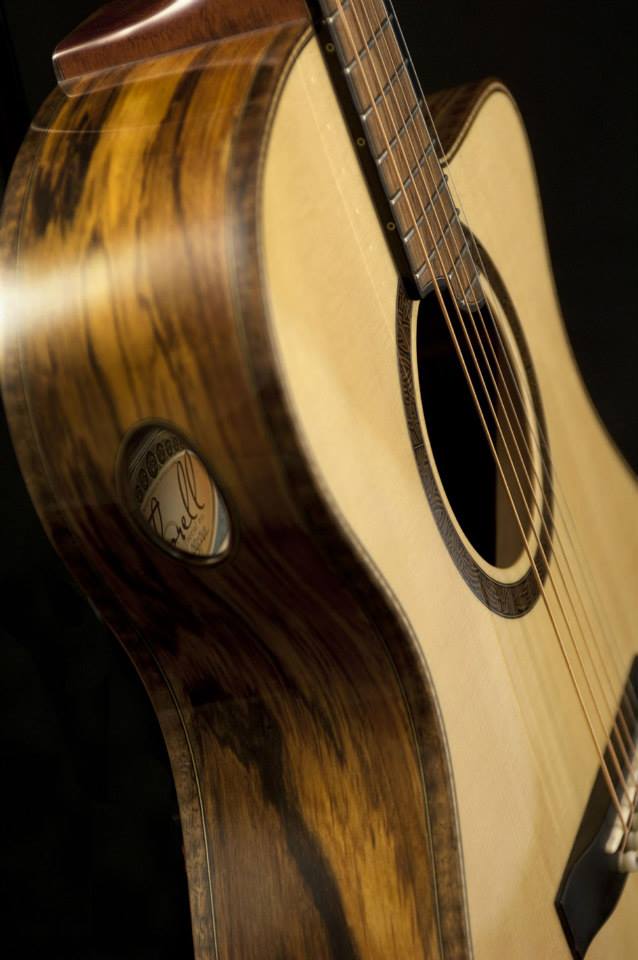
At the very top end of the top price spectrum
are custom guitars that are specially designed and
hand-built by master guitar craftsmen. In fact, we
have an excellent custom guitar builder right here in Logan:
Ryan Thorell. If you are interested in such a guitar,
talk to me and I will arrange a meeting for you with
Ryan. His workshop is less than a block from my
teaching studio. (One of his beautiful guitars is
shown above.)
In general, these handmade guitars are overkill for gigging. Even people who own them don't usually gig with them, so I'm not going to go into detail on them, here.
$2,100-5,000
Most guitar players would agree that two of the
best brands for mass produced, solid-wood, USA-made guitars
are Martin and Taylor. Other excellent instruments in
this price range include solid-wood, USA-made guitars by Larrivée, Breedlove,
Gibson, and Takamine. If you pursue acoustic
guitar throughout your life, it is likely that someday
you'll own one or more of these guitars. I
personally have the most knowledge about Martin and
Taylor, so I will focus on them.
The quintessential "Martin sound" is their D-28
model (below). Martin has been making guitars for
nearly 200 years, and the D-28 has been in their lineup for
nearly 100 years. It has been copied by other
manufacturers ever since, but nobody else has been able to
capture the tone of the D-28, which can be described as rich and
warm. Many people consider it to be the best
sounding guitar in the world. The shape of the D-28
is called a "dreadnought", and it is big and bulky and
uncomfortable to hold, but many guitarists consider it to
be the best sounding guitar in the world. Martin
also makes some other nice models that have smaller and
more comfortable bodies, but what they are famous for is
the D-28. There's nothing else like it.

Taylor is a much younger company, established in
1974. Its commitment to quality has paid off, and it
is now Martin's equal in quality and in beautiful tone, but
it is a very different tone from Martin. The
quintessential "Taylor sound" is their 814ce model
(below). It features a solid spruce top and solid
rosewood back and sides, just like the Martin D-28... but it
sounds VERY different than the Martin. The sound can
be described as bright, clear, and modern. The shape
of the 814ce is called the "Grand Auditorium" body shape,
and it is used on quite a few other Taylor models. The
Grand Auditorium is a full sized guitar body shape, but it
is not as thick as a dreadnought and it has a more curvy
shape that most people find more comfortable to hold.
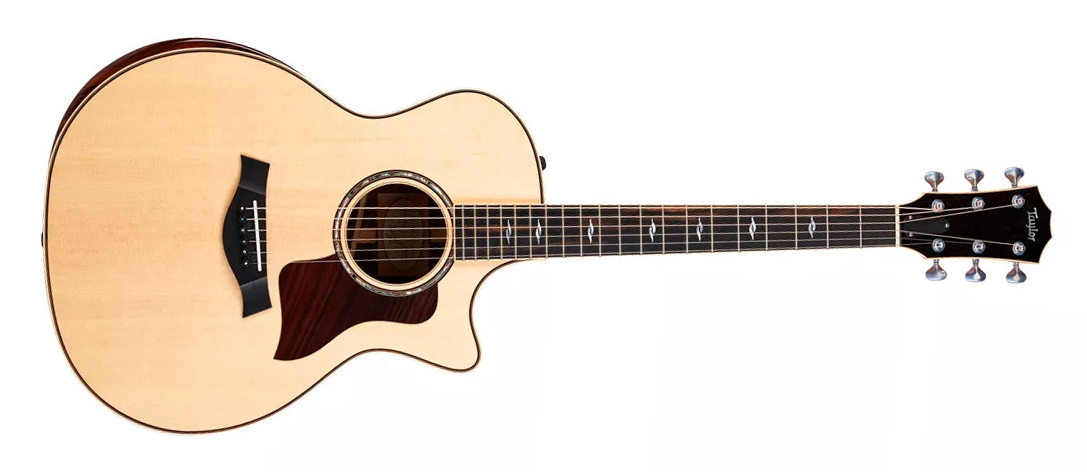
What's fun about Taylor is that they offer a
HUGE variety of models with different body shapes and woods
that sound very different from each other. For
example, I own a beautiful Taylor 324ce Builder's Edition
(below) that has the same body shape as the 814ce (Grand
Auditorium) but instead of a spruce top and
redwood back/sides, it has a mahogany top and ash back and
sides. It has unique overtones and warm harmonics that
make it sound like no other guitar I have ever played...
absolutely gorgeous tone!

I also own a wonderful Taylor 717e (below)
It has a spruce top and rosewood back and sides, and it
sounds nothing like a stereotypical Taylor at all. It
sounds reminiscent of a vintage Gibson but without the
intonation woofiness problems. It is impossible for me
to play either of these guitars without smiling, but they sound VERY different from
each other.

Taylor makes so many other body shapes, and offers many other wood combinations, that I can't even begin to list them all. For example, Taylor is the only major guitar manufacturer that offers guitars made of Hawaiian koa wood, which has a unique tone and is visually gorgeous.
Again, don't limit yourself to Martin and Taylor. If you are shopping for a quality solid-wood, made in the USA guitar, don't overlook Larrivée, Breedlove, Gibson, and Takamine. Each of them has a unique tone that is some people's favorite.
$1,500-2,000
Historically, this price range has been
"no man's land" for
guitars. Too much money
to pay for a foreign
made guitar,
but not a high enough price for the
manufacturers to cover the
cost of building a USA-made
guitar. Until recently,
there wasn't much to get
excited about in this price
range.
But in the last
few years, Taylor has started
making some amazing guitars in
this range. They are
made in Taylor's Mexican
factory, but they are a step
above their normal 100-200
Series. For example, in
2023 they made a pretty blue
214ce DLX LTD that had a
"Trans-blue" colored Lutz
Spruce solid top, layered
maple back and sides, top
quality ES2 electronics.
It sold for about $1,700 and
was worth every penny.
In 2023-24 they have offered
an absolutely gorgeous 224ce
K-DLX (below) that is one of
the most beautiful guitars
ever made (the photo below
does not do it justice).
It has a stunning koa top,
layered koa back and sides,
ES2 electronics, gold
hardware, a pretty
faux-abalone rosette, and a
high gloss finish. It sells
for $2,000 and, in my opinion,
it's a great buy. The
koa wood tames the Taylor
brightness without killing it,
and it adds sweet, warm,
complex overtones that give it
a delightful sound.
These high end Mexican factory
models come with deluxe
cases. They also feature
narrower necks/fretboards than
the American-made models that
make them particularly favored
by female guitarists.

$1,000-1,400
Both Martin and Taylor have
some full-sized, made-in-Mexico models priced in the
$1,000-$1,400 range. I'm personally not a fan of the
Martins in this price range. The manufacturing processes and
quality control in Martin's Mexican factory are not as
good as Taylor's.
That's not to say you can't find a fantastic Martin
that you'll fall in love with, but you may want to have me
check it out before you buy it to make sure the neck is
straight and there is no buzzing. In contrast, the
quality control and manufacturing processes in Taylor's
Mexican factory are top notch,
and I do recommend the Taylor 100 and 200
Series guitars made there.
The Taylor 114ce sells for about $1,000. It's
okay... but if you can afford slightly more, the next step
up is the Taylor 214ce (below) which has a cutaway, rosewood
back and sides, gloss top finish, and a slightly richer
sound. I think that's worth the extra cost. It also comes
with a better carrying bag. (Link
here to hear the difference between the 114ce
and the 214ce). But, to be honest, when you are
approaching the $1,300 price, I'd seriously
consider paying a few more hundred dollars and get
one of the high end Mexican "Deluxe" AND "Limited"
models... or spending half as much and
getting a wonderful sounding Yamaha A1R (see the
next lower price section.)
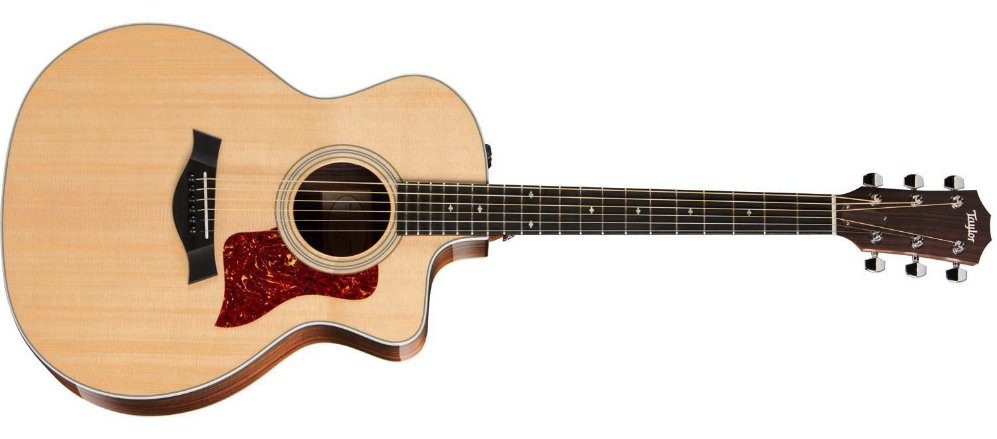
$500-900
Many various
manufacturers offer guitars in this price range, but
most do not have an excellent quality/price ratio,
so there are only two that I recommend. One is
the Taylor GS Mini, which is discussed below, in the
section on 7/8ths size guitars. The
other guitar that I highly recommend in this price
range is the Yamaha A1 series. The A1R (below)
sounds as good as, or better than, other guitars twice its
price. With a full-sized solid Sitka Spruce top and
layered Rosewood sides and back, its tone is
incredible. It comes with electronics and a
cutaway. The only potential downside is that it is a
full sized dreadnought, so it may be uncomfortably big for
women and young teens. But there is no other guitar
with a better sound-to-price ratio than this guitar,
anywhere. Strum a chord, and the only word that
comes out of your mouth is "WOW!!!" This guitar
would be an excellent choice for anyone who can handle the
size of a dreadnought. The A1CR has the same
features as the A1R but with a smaller, curvier body shape
(more like the Taylor Grand Auditorium) and is also an
excellent choice in this price range.

Martin
and Taylor also have guitars in this price range, but the
Martins are low quality and the Taylors are thin sounding
and not great looking. In my opinion, both are
overpriced for the tone you get. And Breedlove has
some absolutely beautiful looking guitars in this price
range, but some of them fall short on tone and
action. Two other brands carried locally (at KSM
Music) are Teton and Ibanez. I'm not a fan of Teton
guitars, at all, in any price range. To my ears they
sound woody and dull compared to Yamaha and Fender
guitars. Ibanez does have some nice models, but I
keep asking myself why anyone would spend $500-700 on an
Ibanez when for the same price they could get an easy to
play Taylor or a fantastic sounding Yamaha.
$200-400
If your budget is too tight for one of the
guitars listed above, I recommend either the Fender CD line
or the Yamaha FG/FS line. These guitars are decent,
for surprisingly
low prices. Smooth straight necks, nice finish,
solid spruce tops, and decent sound. For example, the
Fender CD-140S sells for only $200! (Stay away from
guitars priced under $200; they have a laminated spruce top,
rather than a solid spruce top. The solid top makes a
HUGE difference in the quality of the sound.) The
comparable Yamaha is the FG800 (full sized "dreadnought"
style, below) or the FS800S (smaller, curvy body that might be a
little better for most teens and women.) The Fender and
Yamaha are similar to each other on quality, and identical
on price. Try them both and see which one has a tone
and feel you prefer. (I personally prefer the Yamaha,
but some of my students have liked the Fender better.)
For an extra $100, you can get electronics and a cutaway in
either of these two brands.
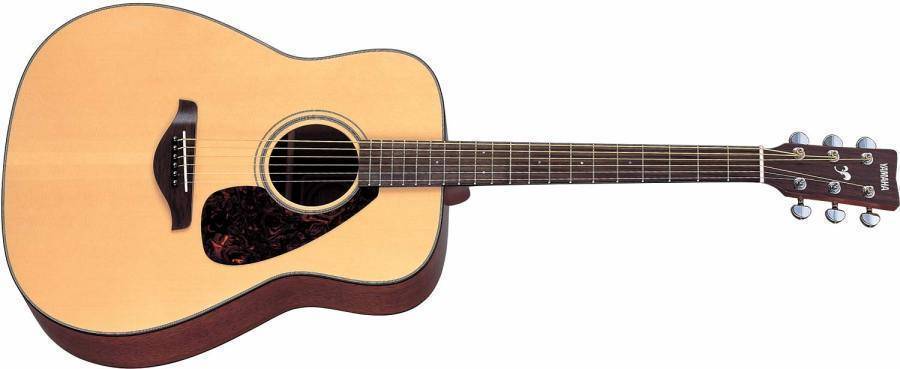
7/8 SIZE GUITARS
7/8ths
size guitars have not only a smaller body, but also
a shorter neck and more compact fret spacing. They can
be an excellent
choice for a woman with short arms and/or small hands, or
for a young teen who is serious about guitar, because the
smaller size makes it a little easier to reach the left hand
fingerings. They can also
be attractive to adults as a second instrument because the small size, light weight, and backpack style
carrying bags make them
easier to take wherever you go (on vacations, to friends'
houses, to
school, to the park, etc.) They are not
quite small enough to be considered true "travel" guitars, but they
are noticeably smaller than full sized guitars, and sometimes
airlines will allow you to put them into overhead bins if
the flight is not full.
That's the good news. The bad news is that
most 7/8ths sized
guitars are terrible instruments that sound shallow and tinny, like they were
made out of a cardboard box. Many of them also have
bad actions that make them hard to play.
The exception is the Taylor GS Mini (below),
which has an amazing sound for its size. In
fact, it actually sounds better than some full-sized
guitars of other brands. A nice
padded gig bag is included. I own one of these, and it
is what I use for my daily guitar. I teach lessons
with it, and I take it with me just about everywhere I
go. I even
occasionally perform with it at venues where I'm not comfortable taking my
expensive full sized Taylors.
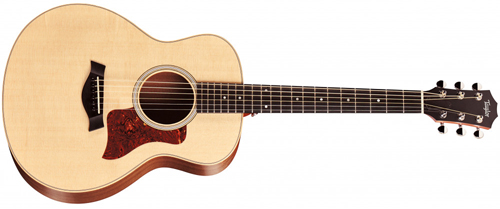
The top of the line GS Mini is the GS Mini Plus. For a couple of hundred dollars more than the all koa model, the Plus model includes the best electronic package Taylor makes (the ES2), and also an upgrade to a very strong very light protective case instead of a gig bag. The Plus is offered with either spruce/rosewood or all koa. The Koa has a beautiful burst finish (below). If I were a small person looking for a guitar to perform with, I'd buy either the GS Mini Koa Plus, or the GS Mini Spruce/Rosewood Plus. The better case and the better electronics are worth the price difference.
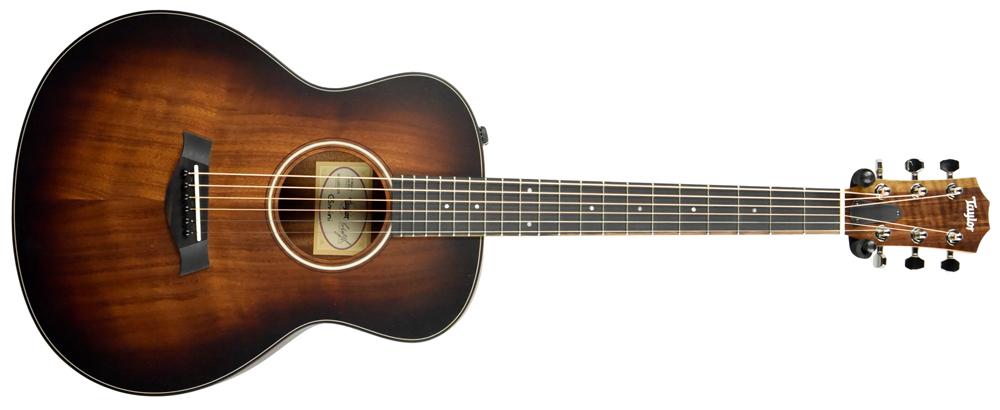
GUITARS FOR CHILDREN
Steel
string acoustic guitars and elementary school children are
not a good match for each other. The vast majority of
young children ages 6-10 who start taking guitar lessons
give up in just a short time. This is because the guitar is
too large, and the neck is too wide for the child to reach the
frets comfortably,
and most importantly the steel strings have WAY much tension for their
small fingers to press onto the frets, making it painful
and frustrating to play. Classical guitars
have nylon strings that are much easier to press, but
their necks are WAY too wide for children to reach across
to fret the strings. Electric guitars also have
strings that are easier to press, but the necks are WAY
too long and the frets are too far apart for kids to
reach, and the guitar bodies are ridiculously heavy for
kids.
For
children 11-12 who are average size for their age, I
recommend a GS Mini (discussed in the previous section,
above). For children ages 9-10 who are of average
size for their age, I recommend a 3/4ths sized steel
string guitar (these are discussed in the next section,
below). For children 8 years old and younger, I
recommend that they learn
ukulele first
and switch to guitar after a couple of years (this
is discussed two section headings below.)
3/4
SIZE GUITARS
Unfortunately, most of the 3/4ths
sized "guitars" that people buy for their children
are not musical instruments at all; they are merely
toys. Every guitar teacher rolls his or her eyes
when a new student shows up with something that the
parents bought for $50 or $80 at WalMart or
whatever. The manufacturing quality is pathetic,
the tone is disgusting, it won't stay in tune, and worst of
all, the action is horrible, making it even more
difficult and painful to play than a full sized
guitar.
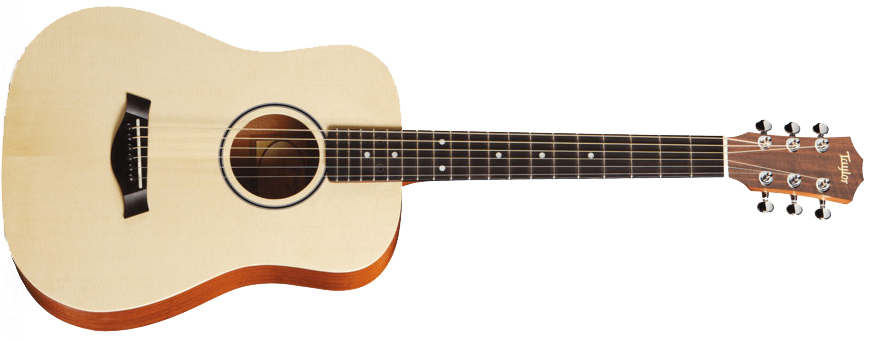
The Baby Taylor (above) and the LX1 Little
Martin (below) are decent instruments. Priced around
$350 new ($250 used), they may seem expensive for a child
who will only play them for a few years before growing out
of them. But keep in mind that, unlike less expensive
instruments, the Baby Taylor or Little Martin can be sold on
the used market when the child grows. I do recommend
these instruments for young students who are genuinely
interested in guitar and firmly committed to practice and
persevere. The Taylor and the Martin are about the
same size, price, and quality as each other, so pick
whichever one you think sounds best. (LINK
HERE to hear the difference; to my ears the Martin has a little more pleasing,
rounded tone, but that's just personal
taste.)
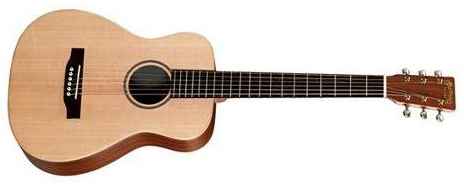
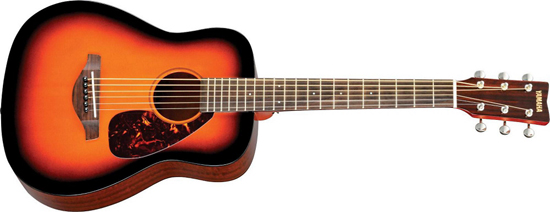
UKULELES
If a young grade school aged child wants to
learn guitar, my recommendation is to start on ukulele
and switch to guitar later.
If your child is 7-8 years old and average size
for his/her age, I highly recommend the "baritone"
ukulele. Baritone ukuleles are bigger than other
ukuleles, but are smaller than mini guitars. The
advantage of the baritone over than the more popular soprano
and concert ukeleles is that it is tuned exactly like the
top four strings of a guitar. As a result, the chords
are named the same as those on a guitar, and the fingering
is identical to that of the top four strings of a
guitar. Thus, graduating from baritone ukulele to
guitar later on is very easy. With a baritone, the
child can play most guitar songs in the original keys
without special "ukulele" music books. Both KSM Music
and The Book Table carry baritone ukuleles and between the
two stores there are almost always a few in stock. If
you buy locally, I recommend the $150-ish price range.
Instruments priced below that are usually poor quality, and
anything priced above that is overkill if the child will be
moving to guitar in a few years.
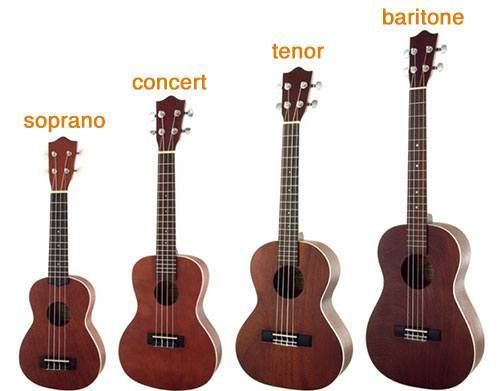
The
baritone ukulele is too large for most 5-6 year olds, so
for very young children, I recommend a soprano or concert
ukulele. But make sure it has gear action tuning
pegs that stick out the sides of the headstock. Stay
away from the "souvenir" ukuleles with friction fit tuning
pegs that stick out of the back of the headstock.
Those are not musical instruments, they are toys, and they
absolutely will NOT stay in tune for more than 10 seconds
of playing.
TRAVEL GUITARS
The definition of "travel guitar" is somewhat
ambiguous. The general idea is a travel guitar is
small enough to take with you when you travel. Some
people call the GS Mini a travel guitar, but in my opinion
it is too large to qualify as a true travel guitar because
it's too big to fit into the overhead bin of an
airline. Most guitars that are marketed as travel
guitars are appx. 3/4ths size, which is generally small
enough to fit in the bins of most airlines. The Baby
Taylor and LX1 Little Martin (discussed above in the section
on 3/4ths size guitars) are the best of that bunch. I
personally dislike their tone and the action, but they are
the highest quality of the 3/4ths size wood instruments, and
may be worth considering... merely because the other 3/4ths
size wood guitars sound even worse than they do.
However, there are two other travel guitars that
are departures from the 3/4ths size wood instruments, that I
think fill the need better because they are more rugged and
are able to withstand the changes in temperature and
humidity and rough handling involved with travel.
First, there is a company named Traveler Guitars
that specializes in guitars specifically designed for
travel. Their Pro Series (below) is an ingenious design
that has the same length of neck and the same scale of frets
as a full-sized guitar, so the feel to your fingers is just
like your normal guitar. Yet it is by far the smallest
of all the travel guitars on the market. They
accomplish this by getting rid of the headstock and the
body. The tuners are moved to where the sound hole
would be in a normal acoustic guitar. It is made of a
single piece of solid maple, so it is very strong.
Because it has no soundboard, it is very quiet (similar to
an unplugged electric guitar.) But it can be plugged
into an amplifier. The Pro Series has two
pickups. One is a piezo pickup under the bridge (just
like most acoustic-electric guitars) that sounds somewhat
like an acoustic guitar, and the other is a single coil
electric guitar pickup that sounds somewhat like an electric
guitar. It has a volume knob for each pickup. It also
features a completely crazy and unique way to listen to it:
there is a stethoscope (just like doctors use) that
allows you to listen to it without headphones or amp or
batteries! Because it is so quiet, you can even play
it in public places like an airport without bothering
other people. It is 2.5 feet long and 6" wide in
storage position, and weighs 3 lbs. Because of the
solid hardwood design, it is rugged enough to take camping
or on a hike and not worry about breaking it. I own
one of these and enjoy taking it places where no other
guitar can go. It sells for $400.
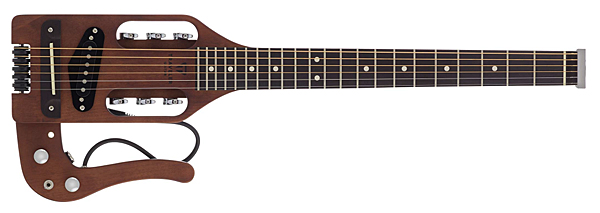
Until recently, there was no practical way to play these guitars for other people to hear, because you needed to haul around a big, heavy amplifier, which obviously defeated the whole point of a travel guitar. Happily, a company called Positive Grid has recently introduced a tiny, powerful, inexpensive, good sounding guitar amp that is perfect for the job: the Spark GO (below). It is lithium battery powered and charges with a USB-C port, and it is so small that it will fit into the pocket of the Traveler Pro Series guitar's gig bag. (Below you can see its size next to an iPhone). It has four programmable amp presets so you can have four different amp sounds at the push of a button, and you can even download free amp presets that other people have created. In addition to different types of amps and tone controls, these presets can include virtual pedals for reverb, delay, chorus, and other sounds. The Spark GO sells for $120, which is a bargain!
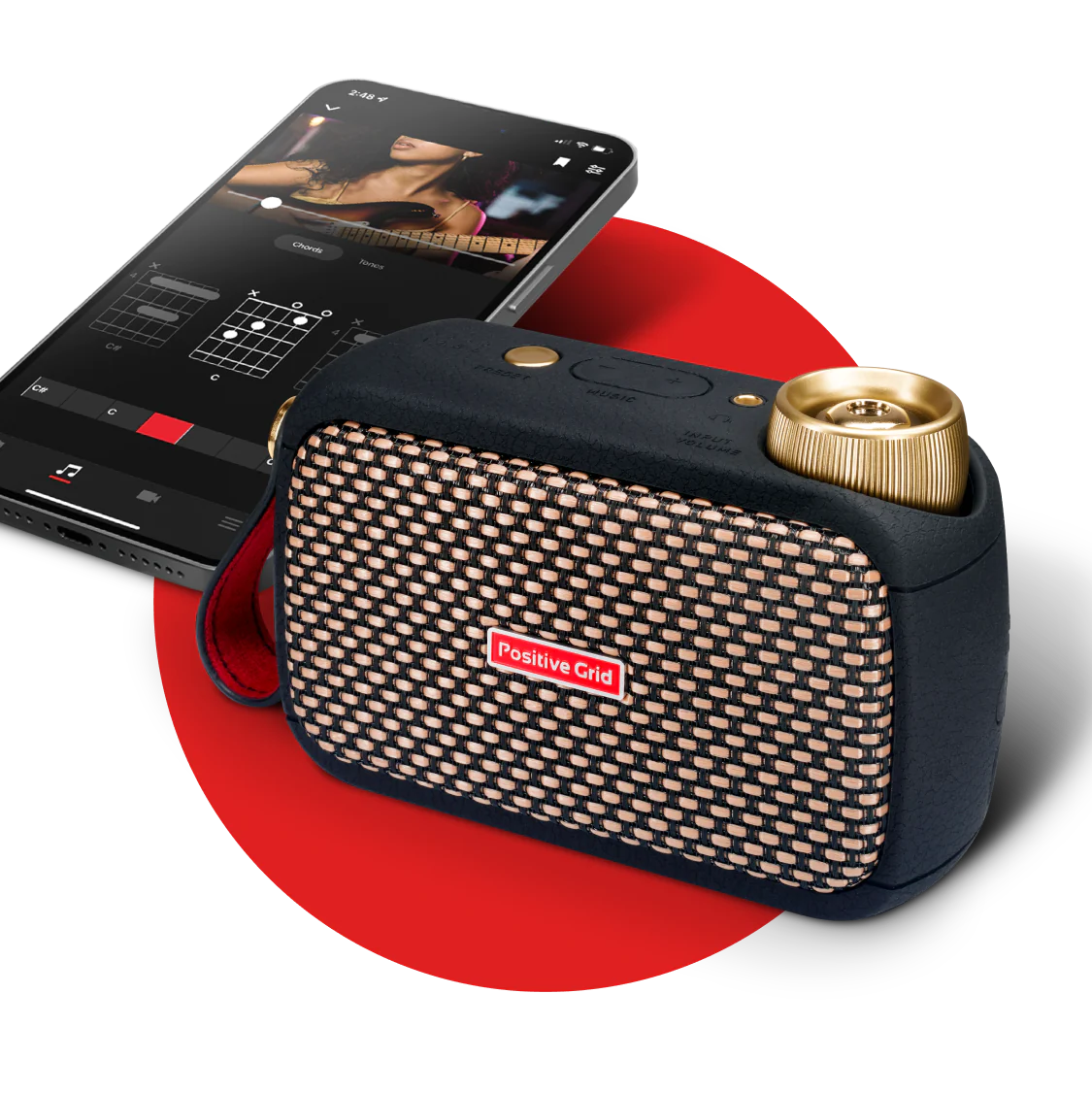
The other innovative option in the travel guitar market is the LAVA ME 2 (below). I have never played one myself, but it is getting rave reviews. It is about the size of a Baby Taylor or Mini Martin (appx. 3/4ths size), but the entire guitar, including soundboard, body, and neck, is all one-piece, unibody, injection-moulded carbon fiber. It sells for $800, and it's nearly indestructible. It has built in reverb, chorus, and delay that work even when the guitar is not plugged in. It is good from 0 to 200 degrees Fahrenheit, and from 10 to 90% humidity, so humidity and temperature are never a concern. It has no truss rod, because the neck never needs adjustment. Reviewers say the neck is very comfortable to play. There are many cool colors to choose from, and from what I've seen online it plays perfectly and sounds awesome for its size.
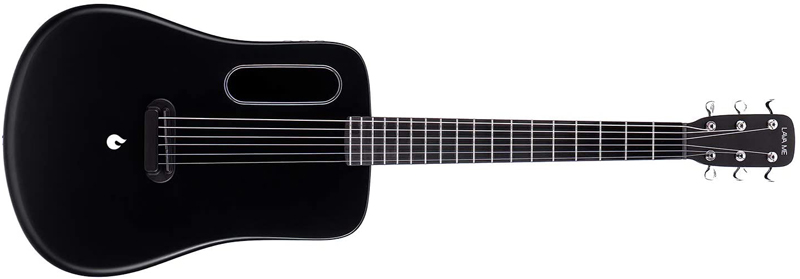
SUMMARY
In summary, in the high price range ($2,000-5,000) the
best mass produced professional level guitars in the
world are made in the USA by Martin, Taylor, Larrivée,
Breedlove, Gibson, and
Takamine. Of these, Taylor
offers the greatest variety to
choose from. In
the medium-high price range ($1,000-2,000), you can't go
wrong with Taylor. In the medium-low price range
($500-900), the Yamaha A1R and A1CR are full sized guitars
that are competitive in sound and quality with guitars
double their price. For those who want a smaller
guitar, the Taylor GS Mini series is an excellent
value. In the low price range ($200-400), Yamaha and
Fender offer the best quality for the price. For
"travel" guitars the smallest is the Traveler, and the
most indestructible and best sounding is the LAVA.
WHERE TO BUY YOUR GUITAR
My advice for buying a performance acoustic
guitar is: 1) Shop in a quality guitar store. Do not
buy guitars online. Buying a guitar you haven't
held in your own hands and played is sort of
like marrying someone you haven't actually met,
thinking that photos and an online description is
sufficient. And 2) don't
pay attention to brand name or
specifications. Instead, go
to Main Street Guitars and KSM Music and
Music Village and buy the guitar that makes
you smile when you play it. Don't
write down the model number and go shop
online. When the one you want is in
your hands, buy that specific guitar.
Martin, Taylor, Gibson, Yamaha, and Fender are
all carried locally at Main Street Guitars, located
downstairs at The Book Table in Logan, which has an
excellent selection and very competitive prices (identical
to those of online dealers). A limited selection of
Breedlove guitars are available at KSM Music.
Larrivée and a wider selection of Breedlove are available
an hour's drive away at Music Village in Riverdale.
LAVA and Traveler are available available online directly
from the manufacturers. (It is okay to buy LAVA and Traveler
online, because LAVA is not made of wood, and Traveler
is made of a single piece of hardwood.)
Buying a used guitar is a gamble, even if you
have held it in your hands, unless you know what problems
to look for. If you are considering
purchasing a used guitar, have me play it first. Don't
be lured into thinking you're getting a bargain by buying a
used guitar for a bargain price. If it has worn frets,
a warped neck, a stripped truss rod, or a bad soundboard,
repairs might cost more than the price of a new guitar.